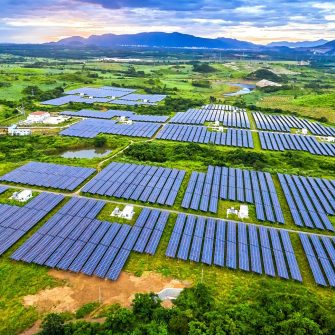How a 50% efficiency leap unlocked a $1tn industry
From the creation of the world’s most efficient solar cell technology to the democratisation of solar power itself – here’s how our research is powering a global solar revolution.

Share this story
Throughout the last five decades, Professor Martin Green and his team of researchers at UNSW have fundamentally transformed photovoltaic technology through the creation of the Passivated Emitter and Rear Cell (PERC) and other advanced cell technologies. In creating such high-performance, low-cost solar options, they’ve paved the way for solar power to become our greatest asset in finding a solution to the global climate crisis.
The 1985 UNSW team which developed the PERC cell. Front row: Michael Taouk, Martin Green, Jianhua Zhao and Stuart Wenham. Second row: Andrew Blakers and Mike Willison. Back row: Ted Szpitalak, Mohan Narayanan and CheeMun Chong. Insert, Aihua Wang.
The pioneering work of Professor Green and his team first made an impact after the group produced solar cells with 18% efficiency – besting the previous world record. “We set our first record for solar performance in 1983 and then for the next 31 years we held that record,” says Professor Green. While the team went on to achieve results of 20% (a number previously thought to be the practical limit for a single-layer silicon solar cell), it was the creation of the PERC that boosted efficiency to 25%.
With this development, PERC technology became the world’s most commercially viable and efficient silicon solar cell technology and is now the lowest cost option for bulk electricity supply across the globe. “We made the world’s best cells in the lab,” explains Professor Green.
"The technology we developed has since accounted for 90% of the global production of solar."
- Professor Martin Green
While the PERC made up about 90% of the world’s solar cell manufacturing output in 2022, the impact of the team’s work is only set to rise with TOPCon – another technology pioneered by the team, boosting this number in 2023.
Going global
While the technology itself made a significant global impact, so too did the way it was shared with the world. Several of Professor Green’s UNSW students went on to play a major role in the establishment of the solar manufacturing industry in Asia. This created strong competition within the market, which was followed by a major reduction in cost for the solar cell technology.
Between 2008-2020, the wholesale price of solar dropped by a factor of 24, from above US$4/Watt to US$0.17/Watt. “That was a by-product of our work we weren’t really anticipating but it’s been just as important or perhaps even more important for the development of low-cost solar than our technical work,” says Professor Green.
This significant cost reduction has not only made solar an affordable option for global communities and industries alike but has allowed for a sizeable move to zero-emissions electricity. “Since 2020, solar has transitioned to being a keystone strategy for mitigating climate change.”
“If you really want a change, you have to make green energy cheaper, and this is what’s driving the uptake of solar in Australia now.”
- Professor Martin Green
In 2008 Martin Green and his team built a wafer containing 6 large PERC cells which achieved 25% efficiency.
While it initially took some time for the cost reduction to become globally recognised, the International Energy Agency acknowledged the outcome in 2020. “They declared that solar now offered the cheapest electricity in history,” says Professor Green. “They are now calling for the uptake of solar and wind as something we should be doing immediately.”
King Charles III with Professor Martin Green at the 2023 QEPrize awards ceremony. Image: QEPrize
Forward focused
For Professor Green and his team, the far-reaching impact of their research has been its own reward after years of hard work. “We didn’t know we were doing it at the time – the main motivation for us was setting new efficiency records,” he explains. “Over those 31 years we improved the performance of the cells by 50% in relative terms, but it took about 18 steps over those 31 years.”
With PERC solar cells now commercially standard throughout the globe, and with sales of technology pioneered by his team expected to exceed US $1 trillion by 2030, Professor Green and his team are continuing to develop, adapt and re-visit their research. “You need a really experienced team to be able to sustain the effort and stop you from going around in circles,” adds Professor Green.
“You need to be making progress and when you do get something to work, you take full advantage of that insight… Then you look for the next idea.”
- Professor Martin Green
Share this story
Read more
Get in touch and see what’s possible.
Ask how we can help your business, industry, or market through collaboration.



